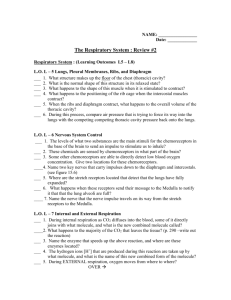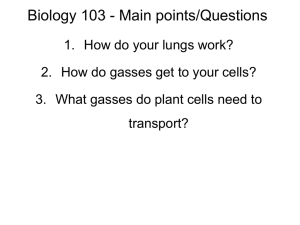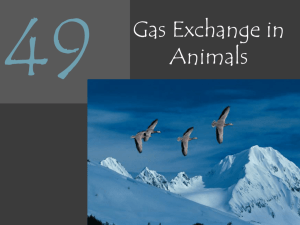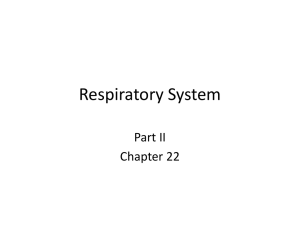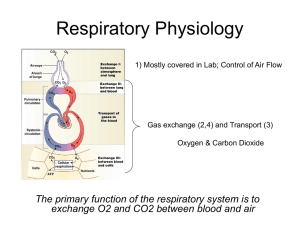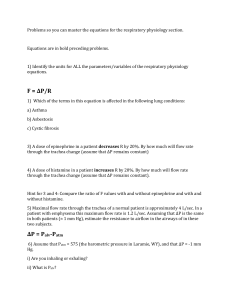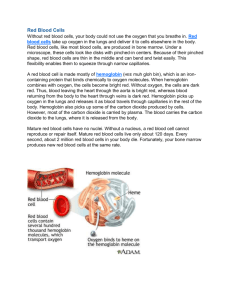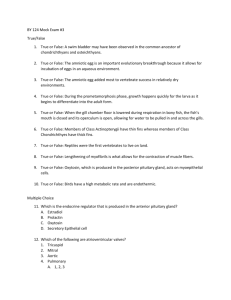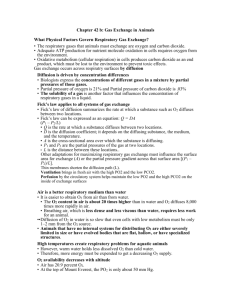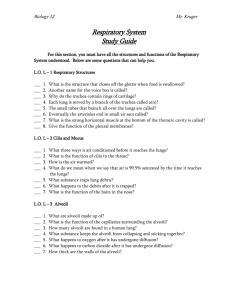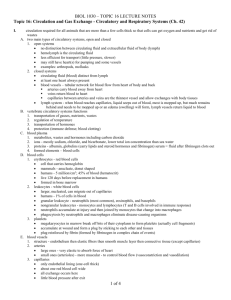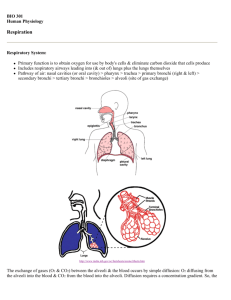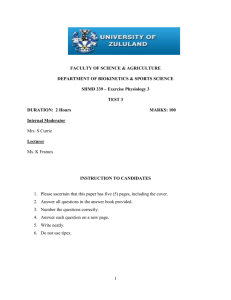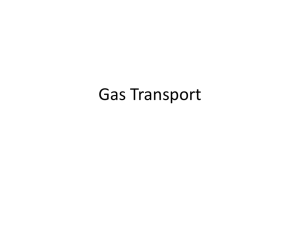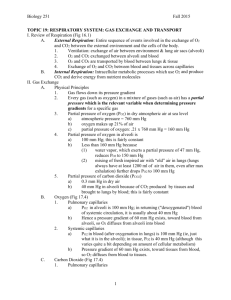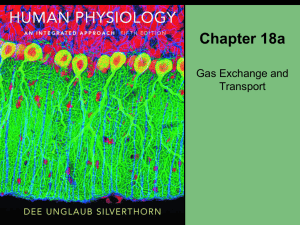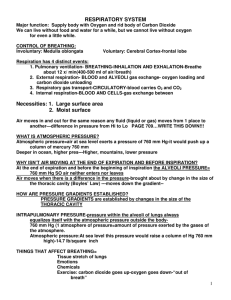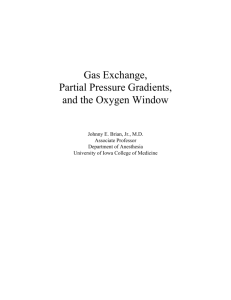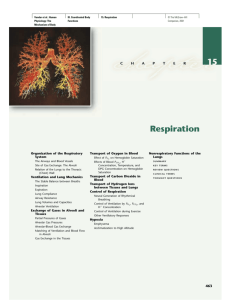Chapter 45 - Respiratory System
advertisement
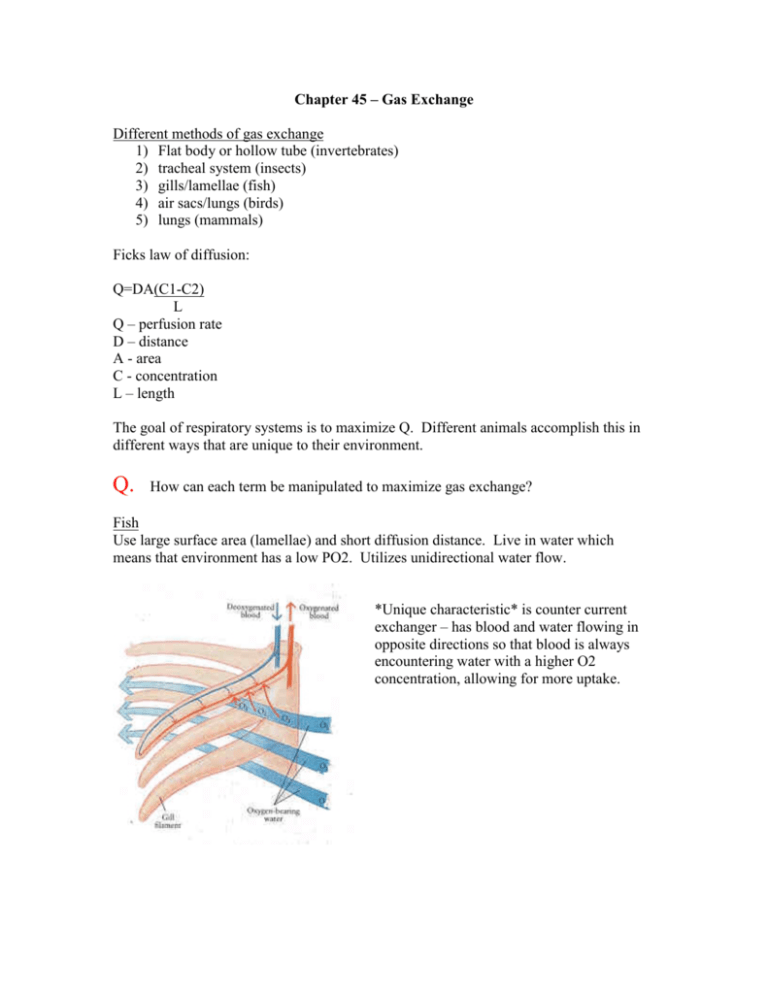
Chapter 45 – Gas Exchange Different methods of gas exchange 1) Flat body or hollow tube (invertebrates) 2) tracheal system (insects) 3) gills/lamellae (fish) 4) air sacs/lungs (birds) 5) lungs (mammals) Ficks law of diffusion: Q=DA(C1-C2) L Q – perfusion rate D – distance A - area C - concentration L – length The goal of respiratory systems is to maximize Q. Different animals accomplish this in different ways that are unique to their environment. Q. How can each term be manipulated to maximize gas exchange? Fish Use large surface area (lamellae) and short diffusion distance. Live in water which means that environment has a low PO2. Utilizes unidirectional water flow. *Unique characteristic* is counter current exchanger – has blood and water flowing in opposite directions so that blood is always encountering water with a higher O2 concentration, allowing for more uptake. Birds Also use large surface area and small diffusion distance. Live in air, which has high PO2, but fly at high altitudes which has lower PO2. *Has unique air sac/lung configuration to create unidirectional air flow over exchanging surfaces. *Uses cross current flow method – air flow is at right angles to blood flow. Q. Why can birds live at higher altitudes than humans? Mammals Mammals breath air with high PO2, but have tidal flow (air enters and exits from same cavity). This lowers actual PO2 inside the lungs, doesn’t allow for continuous fresh flow of air over exchanging surfaces. Has short diffusion distance. *This is overcome by having branching system that terminates in alveoli with extremely large surface area for exchange. As air is inhaled it passes through a branching network of passages that terminate in alveoli: Mouth/nasal passages Layrnx Pharynx Trachea Bronchi Bronchioles Alveoli How lungs work Lungs have surfactant that reduces that surface tension of the surrounding liquid, allowing lung expansion to be easier. They also produce mucus that traps airborne particles and prevents them from entering the alveoli. Inhalation is accomplished by contraction of the diaphragm, which pulls the muscle down toward the gut and creates a negative pressure inside the lungs. This is a type of suction that causes air to flow into the lungs. Exhalation begins when the diaphragm begins to relax. The elastic recoil of the lungs squeezes the air out of the lungs. Forced inhalation and exhalation (beyond your normal, tidal volume) can be done by incorporating the intercostal (between ribs) muscles. Q. How do the alveoli overcome the surface tension that resists their expansion during inhalation? Q. What structure prevents the trachea from collapsing under the negative pressure created by the contracting diaphragm? Gas transport in blood Very little of the total CO2 and O2 carried in the blood is found in the plasma. The majority of O2 is carried by hemoglobin while the majority of CO2 is converted to and carried as bicarbonate. How much O2 the hemoglobin is carrying is a function of the PO2, and the relationship is not linear. The S-shaped curve results from the binding of one molecule of O2 to hemoglobin increasing the likelihood of hemoglobin picking up the next two molecules of O2. This means that the 2nd and 3rd molecules of O2 are more easily picked up and released than the 1st, and this occurs over a smaller change in PO2. The 4th molecule requires a large increase in PO2 to bind. Think of this process in reverse to see how this benefits the organism when O2 is being released. Human hemoglobin at high altitudes is often bound to bisphosphoglycerate. This alters the hemoglobin so that it has a lower affinity for O2: meaning that at any given PO2, hemoglobin will release more of its O2 than it normally would. This gives a right shifted binding curve, and it means that hemoglobin will not be fully saturated. (It releases oxygen #2 and #3 instead.) Animals such as llamas, that normally live at high altitudes, have a left shifted binding curve because they have a higher affinity for O2. Basically, they can pick it up and release it at lower PO2’s than we can. A fetus has a left shifted curve, similar to that of the llama, because it must obtain it’s oxygen from the blood of the mother, an environment with a lower PO2 than air. CO2 is carried primarily as HCO3, bicarbonate ion. This is done by the RBC by converting CO2 to bicarbonate in the tissue, and back again in the lungs. This conversion allows more CO2 to be picked up from the tissues (note how this changes the CO2 concentration gradient). Q. How might the difference in altitude affect the 49ers if they were playing the Broncos in Denver?
